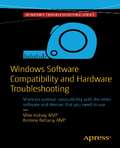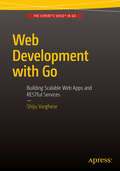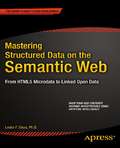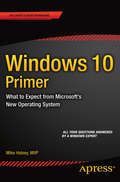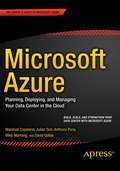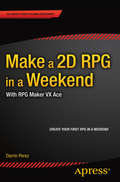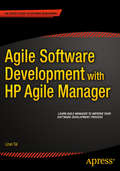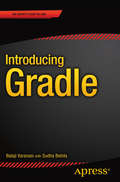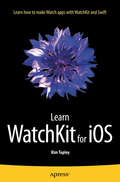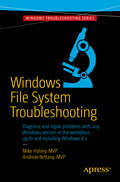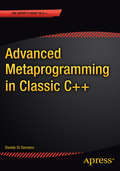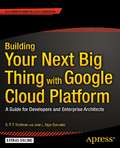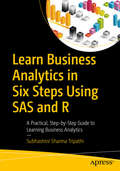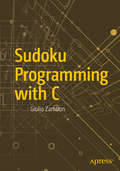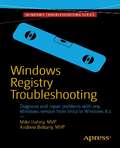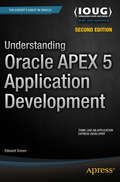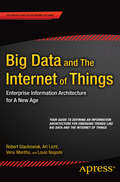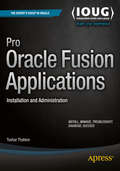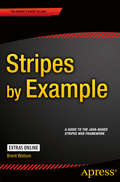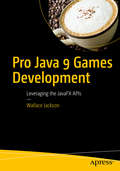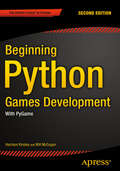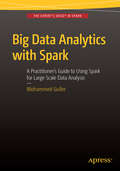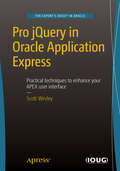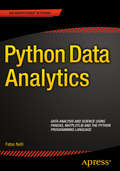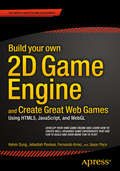- Table View
- List View
Windows Software Compatibility and Hardware Troubleshooting
by Mike Halsey Andrew BettanyAs companies keep their existing hardware and operating systems for more years than ever before, the need to diagnose and repair problems is becoming ever more important for IT Pros and system administrators. Whatever version of Windows you're using (including Windows 10) you'll likely need to maintain compatibility with older software that the company must use for mission-critical operations, or older hardware that's required for specific purposes, but you don't want to sacrifice security for the sake of compatibility. In this briefbook you'll learn how to maintain optimal compatibility with the older software and devices that you need to use. The authors are well-versed in training in classrooms and video, with Andrew Bettany running the IT Academy at the University of York, and IT Masterclasses and Mike Halsey being a teacher, tech-book author, and having produced many tutorial videos under the brand PC Support. tv. What you'll learn What the common software and hardware compatibility issues are in Windows How to resolve software and app compatibility in Windows How to maintain compatibility with browser plug-ins and controls Maintaining compatibility with older hardware The external factors that can affect compatibility Who this book is for IT Pros, Windows expert and power users and system administrators are the audience for this book. Table of Contents Chapter 1: All About Compatibility Chapter 2: Common Software Compatibility Issues Chapter 3: Common Hardware Compatibility Issues Chapter 4: Resolving Software Compatibility Issues Chapter 5: Resolving Hardware Compatibility Issues Chapter 6: External Factors That Affect Hardware
Web Development with Go
by Shiju VargheseTake a deep dive into web development using the Go programming language to build web apps and RESTful services to create reliable and efficient software. Web Development with Go provides Go language fundamentals and then moves on to advanced web development concepts and successful deployment of Go web apps to the cloud. Web Development with Go will teach you how to develop scalable real-world web apps, RESTful services, and backend systems with Go. The book starts off by covering Go programming language fundamentals as a prerequisite for web development. After a thorough understanding of the basics, the book delves into web development using the built-in package, net/http. With each chapter you''ll be introduced to new concepts for gradually building a real-world web system. The book further shows you how to integrate Go with other technologies. For example, it provides an overview of using MongoDB as a means of persistent storage, and provides an end-to-end REST API sample as well. Developers looking for a full-fledged web development framework for building web apps will be introduced to Beego. The book then moves on to demonstrate how to deploy web apps to the cloud using the Google Cloud platform. Finally, the book introduces Docker, a revolutionary container technology platform for deploying containerized Go web apps to the cloud. Web Development with Go provides: Fundamentals for building real-world web apps in Go Thorough coverage of prerequisites and practical code examples Demo web apps for attaining a deeper understanding of web development A reference REST API app which can be used to build scalable real-world backend services in Go A thorough demonstration of deploying web apps to the Cloud using the Google Cloud platform, and Docker for deploying Go servers Go is a high-performance language while providing greater level of developer productivity, therefore Web Development with Go equips you with the necessary skills and knowledge required for effectively building robust and efficient web apps by leveraging the features of Go. What you''ll learn Fundamentals of the Go programming language How to develop web apps and RESTful services using the Go internal package net/http How to persist data into MongoDB from Go web apps How to develop web apps using Go third-party packages How to deploy Go web apps to the Google Cloud platform Who this book is for Intermediate and advanced web developers looking to gain a deep insight of Go. Table of Contents Chapter 1: Getting Started With Go Chapter Goal: Introduces the reader to the Go programming language, and explains how to set up Go on the user''s machine. This chapter will also provide basic sample programs with Go. Introducing Go Why Go Installing Go Sample programs with Go Summary Chapter 2: Go Fundamentals Chapter Goal: Provide tutorials for understanding the features of Go with the help of practical samples. 1. Packages 2. Go Tools 3. Array 4. Slice 5. Map 6. Defer 7. Panic 8. Recover Summary Chapter 3: User Defined Types and Concurrency Chapter Goal: This chapter further explores the features of Go. Unique features such as user-defined types and concurrency will be explained in detail with the help of examples and samples. Struct Interface Concurrency Goroutines Channels Summary Chapter 4: Getting Started with Web Development Chapter Goal: This chapter introduces the reader to web development in Go with the internal package net/http. Also, complex routing scenarios will be covered. The chapter will employ a static web server and basic web app for practical understanding of the process. Introducing net/http package Build a simple web server http. Handler Interface Build a static web server Build a basic web app URL router Gorilla mux URL router Summary Chapter 5: Go Templates Chapter Goal: This chapter introduces the readers to Go templates with the internal package html/template. Also, the reader will learn how to build a web app practically using html/template with net/http package. Introducing the html/template pa...
Mastering Structured Data on the Semantic Web
by Leslie F. SikosA major limitation of conventional web sites is their unorganized and isolated contents, which is created mainly for human consumption. This limitation can be addressed by organizing and publishing data, using powerful formats that add structure and meaning to the content of web pages and link related data to one another. Computers can "understand" such data better, which can be useful for task automation. The web sites that provide semantics (meaning) to software agents form the Semantic Web, the Artificial Intelligence extension of the World Wide Web. In contrast to the conventional Web (the "Web of Documents"), the Semantic Web includes the "Web of Data", which connects "things" (representing real-world humans and objects) rather than documents meaningless to computers. Mastering Structured Data on the Semantic Web explains the practical aspects and the theory behind the Semantic Web and how structured data, such as HTML5 Microdata and JSON-LD, can be used to improve your site''s performance on next-generation Search Engine Result Pages and be displayed on Google Knowledge Panels. You will learn how to represent arbitrary fields of human knowledge in a machine-interpretable form using the Resource Description Framework (RDF), the cornerstone of the Semantic Web. You will see how to store and manipulate RDF data in purpose-built graph databases such as triplestores and quadstores, that are exploited in Internet marketing, social media, and data mining, in the form of Big Data applications such as the Google Knowledge Graph, Wikidata, or Facebook''s Social Graph. With the constantly increasing user expectations in web services and applications, Semantic Web standards gain more popularity. This book will familiarize you with the leading controlled vocabularies and ontologies and explain how to represent your own concepts. After learning the principles of Linked Data, the five-star deployment scheme, and the Open Data concept, you will be able to create and interlink five-star Linked Open Data, and merge your RDF graphs to the LOD Cloud. The book also covers the most important tools for generating, storing, extracting, and visualizing RDF data, including, but not limited to, Protégé, TopBraid Composer, Sindice, Apache Marmotta, Callimachus, and Tabulator. You will learn to implement Apache Jena and Sesame in popular IDEs such as Eclipse and NetBeans, and use these APIs for rapid Semantic Web application development. Mastering Structured Data on the Semantic Web demonstrates how to represent and connect structured data to reach a wider audience, encourage data reuse, and provide content that can be automatically processed with full certainty. As a result, your web contents will be integral parts of the next revolution of the Web. What you''ll learn Extend your markup with machine-readable annotations and get your data to the Google Knowledge Graph Represent real-world objects and persons with machine-interpretable code Develop Semantic Web applications in Java Reuse and interlink structured data and create LOD datasets Who this book is for The book is intended for web developers and SEO experts who want to learn state-of-the-art Search Engine Optimization methods using machine-readable annotations and machine-interpretable Linked Data definitions. The book will also benefit researchers interested in automatic knowledge discovery. As a textbook on Semantic Web standards powered by graph theory and mathematical logic, the book could also be used as a reference work for computer science graduates and Semantic Web researchers. Table of Contents 1. Introduction to the Semantic Web 2. Knowledge Representation 3. Linked Open Data 4. Semantic Web Development Tools 5. Semantic Web Services 6. Graph Databases 7. Querying 8. Big Data Applications 9. Use Cases
Windows 10 Primer
by Mike HalseyWith Windows 10 arriving later in 2015, many questions remain to be answered, both for businesses and home users. Will it provide the compatibility of Windows XP, and the usability of Windows 7? Will it banish forever the problems associated with Windows 8? In this book, Windows expert, author and MVP Mike Halsey answers the questions you have and details hidden and improved features that can revolutionize your security, productivity and user experience. Whether you're an IT professional considering or planning an upgrade to your company's PCs or a Windows enthusiast eager to find out if Microsoft has finally built a truly modern Windows experience, Windows 10 Primer has the answers to all your most important questions. What you'll learn Get to know Microsoft's new OS, before it arrives Every change and improvement explained, feature by feature Reasons to upgrade from Windows XP or Windows 7 and key things to look out for Discover how the new interface will be familiar to Windows 7 users while empowering people to be more productive Learn how new security features will make life safer for users, and simpler for IT pros Get to know your way around how BYOD (bring your own device) can be handled in the workplace, different device types, and how manageability is at the core of Windows 10 Find out about the unified app platform and how it can simplify business software development while opening new opportunities for productivity and usability See how the new unified OS model and more flexible update options can benefit your business Who this book is for IT professionals, system admins, power users, enthusiasts Table of Contents Chapter 1: Introducing Windows 10 Chapter 2: New and Improved Features in Windows 10 Chapter 3: Windows 10 for Phone and Other Devices Chapter 4: What's New for End Users? Chapter 5: What's New for Businesses? Chapter 6: Maximizing Security and Productivity
Microsoft Azure
by Marshall Copeland Julian Soh Anthony Puca Mike Manning David GollobWritten for IT and business professionals, this book provides the technical and business insight needed to plan, deploy and manage the services provided by the Microsoft Azure cloud. Find out how to integrate the infrastructure-as-a-service (IaaS) and platform-as-a-service (PaaS) models with your existing business infrastructure while maximizing availability, ensuring continuity and safety of your data, and keeping costs to a minimum. The book starts with an introduction to Microsoft Azure and how it differs from Office 365--Microsoft''s ''other'' cloud. You''ll also get a useful overview of the services available. Part II then takes you through setting up your Azure account, and gets you up-and-running on some of the core Azure services, including creating web sites and virtual machines, and choosing between fully cloud-based and hybrid storage solutions, depending on your needs. Part III now takes an in-depth look at how to integrate Azure with your existing infrastructure. The authors, Anthony Puca, Mike Manning, Brent Rush, Marshall Copeland and Julian Soh, bring their depth of experience in cloud technology and customer support to guide you through the whole process, through each layer of your infrastructure from networking to operations. High availability and disaster recovery are the topics on everyone''s minds when considering a move to the cloud, and this book provides key insights and step-by-step guidance to help you set up and manage your resources correctly to optimize for these scenarios. You''ll also get expert advice on migrating your existing VMs to Azure using InMage, mail-in and the best 3rd party tools available, helping you ensure continuity of service with minimum disruption to the business. In the book''s final chapters, you''ll find cutting edge examples of cloud technology in action, from machine learning to business intelligence, for a taste of some exciting ways your business could benefit from your new Microsoft Azure deployment. What you''ll learn What Microsoft Azure can do (infrastructure and platform as a service), and reasons for adoption How to plan for successful integration of Azure with your existing IT infrastructure How to use the Azure management portal to manage basic workload items, and how to use the enterprise portal for monitoring and reporting How to create web sites on Azure to save platform running and management costs and scale easily How to create virtual machines on Azure and how to migrate them safely from an existing infrastructure When and why to choose different storage options on Azure How to extend your on-premise network to Azure How to handle identity management using Azure Active Directory, from the free edition to the full Enterprise Mobility Suite How to manage your resources with clusters and affinity groups to maximize availability, minimize costs, and optimize disaster recovery scenarios Advanced applications of Azure to machine learning and business intelligence Who this book is for This book is for IT and business administrators and managers looking to deploy some or all of Microsoft Azure''s services to their existing business infrastructure, while maximizing availability, building robust disaster recovery solutions, and minimizing costs. Table of Contents Part I: Introducing Microsoft Azure Chapter 1: Why Choose Microsoft Azure Chapter 2: Azure Services Overview Chapter 3: Azure Real-World Scenarios Chapter 4: Planning Your Azure Deployment Part II: Microsoft Azure Quick Start Chapter 5: Getting Started with Azure Websites Chapter 6: Getting Started with Azure Virtual Machines Chapter 7: Understanding Your Storage Options Part III: Extending Your On-Premise Environment with Azure Chapter 8: Extending Your Network with Azure Chapter 9: Identity Management with Azure Active Directory Chapter 10: Extending Azure Active Directory Chapter 11: Clusters, Regional VNets, High Availability, and Disaster Recovery Chapter 12: Migrating Your Virtual Machines to Azure Chapter 13: Monitoring and Reporting Part IV: Futures and Advanced Topics Chapter 1...
Make a 2D RPG in a Weekend
by Darrin PerezMake a 2D RPG in a Weekend shows you how to create your very own dungeon crawler game in RPG Maker VX Ace in a single weekend. The entire process, from start to finish, is covered within this book. You will see a variety of dungeon maps and events, all broken down for your convenience. One of the hardest parts of game development is actually finishing a game, but it is also one of the most important steps on the way to becoming a game developer. If you have yet to finish a game, this book will give you the confidence and resources you need to finally be able to create your very own RPG. Once you've completed the game in this book, you'll be able to modify it as much as you like, adding new monsters and quests, and you'll have the skills to go on to create your second game all by yourself. Among the topics covered in this book are: * Creating various types of enemy encounters via the use of the eventing system. * Creating a special area that allows the player to pick their character of choice instead of being forced to play a particular character. * Clever uses of events to create items that allow the player to return to town instantly and summon vehicles to their side. What you'll learn * Create playable characters that have different attributes and playstyles. * Create a wide variety of weapons, armors, and items for the player to purchase, find, and use. * Design dungeon levels with specific goals in mind. * Create treasure chests with random contents or contents based on the player's character. * Create doors that require keys or puzzles to unlock. * Create a variety of enemy encounters. Who this book is for Make a 2D RPG in a Weekend is for anyone who has ever wanted to create a game from scratch. All you need is this book and a copy of RPG Maker VX Ace. Table of Contents Chapter 1: Laying Out the Framework Chapter 2: The Characters of our Game Chapter 3: The Upper Catacombs of Eagle's Crossing Chapter 4: Populating Eagle's Crossing Chapter 5: The Lower Catacombs of Eagle's Crossing Chapter 6: The Caves Chapter 7: The Pixie's Forest (West) Chapter 8: The Pixie's Forest (East) Chapter 9: The Ancient Temple Chapter 10: What Comes Next Chapter 11: Appendix
Agile Software Development with HP Agile Manager
by Liran TalAgile development practices have been widely adopted in a variety of organizations, yet only a few tools are available to help make the practical process of managing agile teams less painful and more successful. HP Agile Manager is a purpose-built SaaS-based Agile planning tool. HP Agile Manager provides a simpler, smarter way to manage collaborative development. Liran Tal provides a practical, concise approach to using Agile Manager in a variety of settings to better plan, conduct, and manage software releases within development teams. His step-by-step approach will show you how to plan your product's features, streamline the agile sprint process, work with user stories, and track defects throughout the development process. Agile Manager can work for small startups, mid-sized teams, as well as scale up for bigger organizations as a cost-effective and flexible tool to apply agile techniques to improve your software development process. What you'll learn How to apply the concepts of agile management in software development teams to better execute and increase performance and delivery How a software release cycle works, how to manage sprints, set timelines, build a products backlog, and manage day to day team tasks How to leverage agile best practices to guide your team through effective release planning and team collaboration Understand and apply agile software delivery concepts such, estimating and prioritizing user stories. Streamlining sprints planning, execution, and retrospective How to setup, and use HP Agile Manager to effectively manage software lifecycle through agile methodology, and learn how to leverage Agile Manager's flexible workflow to meet your team requirements and processes Using Agile Manager's dashboards for real-time view into the current status of releases, and sprints to gain insights and pro-actively respond to changes, as well as tracking your team progress, work-load, and keeping an eye on tasks burn-down, or cumulative flow Who this book is for Developers, quality engineers, development team leaders and new managers will find this book to serve them well in learning and applying agile methodologies in their teams. Table of Contents Chapter 1 - The Agile World Chapter 2 - Getting Started with Agile Manager Chapter 3 - Setup your Agile Manager Chapter 4 - Building the Product Backlog Chapter 5 - Streamlining work in the Release Backlog Chapter 6 - The Dashboard Chapter 7 - Helpful Resources and Support
Introducing Gradle
by Balaji VaranasiThis concise book is a quick-start primer on the Gradle build automation tool. It provides a general introduction to Gradle, including how to set it up and the basics of Groovy, the language used for creating Gradle build files. The book also provides practical guides to writing tasks and actions and to understanding the build life cycle. Furthermore, it takes you step-by-step through the creation and use of a custom plugin. After reading and using Introducing Gradle, you will have an understanding of Gradle's dependency management and how single and multi-projects are structured and configured. It also teaches you how to use Gradle for publishing artifacts to local and Nexus remote repositories. Finally, the book covers Jenkins support for Gradle. What you'll learn What Gradle is and how it compares with Ant, Maven, and more How to set up and test Gradle Basic Groovy language features What tasks and projects are How to use out-of-the-box plugins and create custom ones Dependency management with Gradle How to publish artifacts to local and remote repositories How to configure Jenkins to work with Gradle How multi-projects are organized Who this book is for This book is for programmers and build-automation engineers who are new to Gradle. Some exposure to Java is helpful but no knowledge of Groovy is required. Table of Contents 1. Introduction 2. Setting up Gradle 3. Groovy Language Primer 4. Understanding Gradle Builds 5. Projects and Plugins 6. Dependency Management 7. Multi-Project Builds 8. Publishing Artifacts 9. Continuous Integration
Learn WatchKit for iOS
by Kim TopleyLearn WatchKit for iOS covers the development of applications for the new Apple Watch using the WatchKit framework in iOS 8 and the Swift programming language. In this book, an Apple Watch application is an extension to an existing iOS app and is packaged and submitted to the App Store along with it. Using a suite of simple examples, Kim Topley, co-author of Beginning iPhone Development with Swift, introduces and explains every feature of WatchKit and the associated technologies that you'll need to understand to build Apple Watch applications for iOS 8, culminating in a complete WatchKit application that shows weather forecast information for various cities around the world on the Apple Watch. What you'll learn How to build an application for the Apple Watch as an extension of an existing iOS app. How to use all the features of the WatchKit framework in iOS 8. How to integrate your Watch app with its hosting iOS app and how to communicate between them. How to build a Glance for your WatchKit app to make the most useful information more easily available to your users. How to handle notifications. How to use handoff to allow the user to quickly switch to your WatchKit app from its Glance or when handling a notification. How to build, test and debug your Watch App on the simulator and on a real watch. Who this book is for This book is for existing iOS developers who want to understand and use WatchKit to extend their application onto the Apple Watch. Readers are assumed to have basic knowledge of iOS development. Table of Contents Chapter 1. Welcome to the Apple Watch Chapter 2. Interface Controllers and Layout Chapter 3. Watch User Interface Objects Chapter 4. More Watch User Interface Objects Chapter 5. Controller Navigation Chapter 6. Tables and Menus Chapter 7. Building a WatchKit App Chapter 8. Glances, Settings, and Handoff Chapter 9. Notifications
Windows File System Troubleshooting
by Andrew Bettany Mike HalseyThe Windows file system is large and complex, featuring not only a huge number of essential files and folders for the Windows OS, your software and hardware, but also several different underlying file systems that manage and maintain file integrity on your disks. In this book you''ll learn how to navigate around the Windows file structure (up to Windows 8. 1), with what does what and how essential everything is. Additionally we''ll show you how to effectively manage file, folder and security permissions to ensure users get what the access they need, and no more. We''ll also show you how to repair the underlying disk file system should something go horribly wrong. What you''ll learn 1) The structure of the Windows OS file system 2) The differences between different disk file structures 3) How to manage and maintain file ownership, permissions and security 4) How to manage and maintain file system security and encryption 5) How to recover an unbootable file system Who this book is for IT Pros, Windows expert and power users and system administrators are the audience for this book. Table of Contents Chapter 1: Introducing the Windows File System Chapter Goal: A deep dive into the structure of Microsoft Windows and how it manages and arranges OS, update and software files and hardware drivers The Windows File Structure Critical Windows System Files and Folders Managing software and apps Windows hardware driver files and management Managing updates in Windows Chapter 2: Understanding NTFS, FAT and ReFS File Systems Chapter Goal: The main Windows disk file systems and structures detailed Introducing the Windows disk file systems NTFS FAT (FAT32 / exFAT) ReFS Chapter 3: Permissions, Ownership and Auditing Chapter Goal: A common issue with Windows is managing correct file permissions and ownership, this chapter is a complete guide in managing these effectively Managing file, folder and disk permissions Managing file and folder ownership Successfully auditing Windows files, folders and assets Chapter 4: Managing File Security Chapter Goal: Security is essential with PCs in the workplace and at home. This chapter will teach the reader how to effectively secure their Windows OS, software and files Managing Windows, file, folder and disk security Managing security for documents and both disk and network assets Maintaining security best-practice in Windows Chapter 5: Managing and Troubleshooting Encryption and Compression Chapter Goal: This chapter will teach the reader how to effectively manage and deploy security and compression on their files, folders and disks Using and managing Windows file compression Using and managing EFS in Windows Using and Managing Bitlocker and Bitlocker To Go Chapter 6: Troubleshooting the Windows File System Chapter Goal: The disk file system in Windows is also prone to errors, this chapter will get readers started in diagnosing and troubleshooting errors. How disk file system errors occur Common disk file system errors Diagnosing and repairing common disk file system errors Chapter 7: Booting the unbootable - Repairing the Windows Boot System Chapter Goal: If a PC won''t start it''s likely that the boot system will need to be repaired. This chapter is a complete guide on how to automatically and manually fix this in Windows Automatically repairing the Windows boot system Effecting manual repair to the Windows boot system Rebuilding a corrupt Windows boot system Chapter 8: Restoring Files and Folder Security Settings Chapter Goal: Sometimes it all goes horribly wrong and users can be locked out of just about everything. This chapter will teach readers how to manually reset the file and folder permissions on all files and documents in a safe and secure way. When might you need to universally reset permissions? Using ICACLS to reset file permissions and ownership Chapter 9: Repairing the Windows File System using a Portable OS Chapter Goal: If Windows is unbootable or the file system corrupt, a portable OS on USB Flash Drive or DVD can still be used to rescue the OS and your...
Advanced Metaprogramming in Classic C++
by Davide Di GennaroTake a detailed and intense look into template metaprogramming (TMP) using classic C++. Tackle language aspects, design patterns, examples and applications, with special emphasis on small reusable techniques that will improve the quality of daily work. Advanced Metaprogramming in Classic C++: Third Edition is a book to sit with and learn from. Users of its prior editions point out that they come back to it over and over. This edition enhances the readability and clarity of the discussion. The two newer standards are not used in the code so that the examples can be rich, illustrate the point, and be run with confidence. The code can be readily adapted to include the elements of the Modern C++ standards. The gain for the reader is that TMP is presented in the book as a set of techniques that will enable a new style to your C++ coding while making it exceptionally clear and efficient. The approach in the book is used to maximize compatibility and clearly illustrate the techniques, enabling the reader to comprehend difficult material without the burdens of compiler errors, and other unnecessary complexities and enabling a much more intense treatment of the subject. For those interested in Modern C++, all subsequent additions to the C++ language are fully compatible with the code in this book and users familiar with them can leverage the techniques introduced in C++XX to make the patterns in this book even more powerful. There is a chapter that discusses issues regarding the two newer standards and the basics needed to program for the newer standards are readily available online. What makes the book exceptional is the level of understanding of the concepts involved imparted by the author. This is not just a rote overview of metaprogramming. You will truly understand difficult topics like static assertions, how to write metafunctions, overload resolution, lambda expressions, and many others. More than that, you will work through them with practical examples guided by the author's frank explanations. This book requires you to think and to learn and to understand the language so that you can program at a higher level. What you'll learn What templates and the small object toolkit are, and how to use them How to do overload resolution How to do metaprogramming with interfaces, algorithms, functors and refactoring How to work with code generators What is opaque type principle and how to use it How to work with debugging templates and more A chapter devoted to issues surrounding C++0x and C++14 Who this book is for This book is for experienced C++ programmers who want to learn more. Table of Contents Part I 1. Templates 2. Small Object Toolkit Part II 3. Static Programming 4. Overload Resolution 5. Interfaces 6. Algorithms 7. Code Generators 8. Functors 9. Opaque Type Principle Part III 10. Refactoring 11. Debugging Templates 12. C++0X 13. Appendix A: Exercises 14. Appendix B: Bibliography
Building Your Next Big Thing with Google Cloud Platform: A Guide for Developers and Enterprise Architects
by S. P. T. Krishnan Jose L. Ugia GonzalezBuilding Your Next Big Thing with Google Cloud Platform shows you how to take advantage of the Google Cloud Platform technologies to build all kinds of cloud-hosted software and services for both public and private consumption. Whether you need a simple virtual server to run your legacy application or you need to architect a sophisticated high-traffic web application, Cloud Platform provides all the tools and products required to create innovative applications and a robust infrastructure to manage them. Google is known for the scalability, reliability, and efficiency of its various online products, from Google Search to Gmail. And, the results are impressive. Google Search, for example, returns results literally within fractions of second. How is this possible? Google custom-builds both hardware and software, including servers, switches, networks, data centers, the operating system''s stack, application frameworks, applications, and APIs. Have you ever imagined what you could build if you were able to tap the same infrastructure that Google uses to create and manage its products? Now you can! Building Your Next Big Thing with Google Cloud Platform shows you how to take advantage of the Google Cloud Platform technologies to build all kinds of cloud-hosted software and services for both public and private consumption. Whether you need a simple virtual server to run your legacy application or you need to architect a sophisticated high-traffic web application, Cloud Platform provides all the tools and products required to create innovative applications and a robust infrastructure to manage them. Using this book as your compass, you can navigate your way through the Google Cloud Platform and turn your ideas into reality. The authors, both Google Developer Experts in Google Cloud Platform, systematically introduce various Cloud Platform products one at a time and discuss their strengths and scenarios where they are a suitable fit. But rather than a manual-like "tell all" approach, the emphasis is on how to Get Things Done so that you get up to speed with Google Cloud Platform as quickly as possible. You will learn how to use the following technologies, among others: Google Compute Engine Google App Engine Google Container Engine Google App Engine Managed VMs Google Cloud SQL Google Cloud Storage Google Cloud Datastore Google BigQuery Google Cloud Dataflow Google Cloud DNS Google Cloud Pub/Sub Google Cloud Endpoints Google Cloud Deployment Manager Author on Google Cloud Platform Google APIs and Translate API Using real-world examples, the authors first walk you through the basics of cloud computing, cloud terminologies and public cloud services. Then they dive right into Google Cloud Platform and how you can use it to tackle your challenges, build new products, analyze big data, and much more. Whether you''re an independent developer, startup, or Fortune 500 company, you have never had easier to access to world-class production, product development, and infrastructure tools. Google Cloud Platform is your ticket to leveraging your skills and knowledge into making reliable, scalable, and efficient products--just like how Google builds its own products. What you''ll learn * A brief introduction to Cloud Computing * Distinctive characteristics of Google Cloud Platform * The right way to do Authentication, Authorization to access Google Cloud Platform resources and user''s data * An overview of Google Cloud Platform technologies including compute, storage, networking, Big Data and application services. * Build, maintain and iterate over a backend infrastructure on Google Cloud Platform. * Optimize and scale existing projects on Google Cloud Platform. * Perform Big Data analytics using Google technologies. * Host web services in Cloud Platform and orchestrate complex applications with ease. * Architecture recipes using several Google Cloud Platform harmoniously Who this book is for Application Developers and Enterprise Architects seeking a robust and powerful cloud-hosted, backend, infrastructure for apps,...
Learn Business Analytics in Six Steps Using SAS and R
by Subhashini Sharma TripathiApply analytics to business problems using two very popular software tools, SAS and R. No matter your industry, this book will provide you with the knowledge and insights you and your business partners need to make better decisions faster. Learn Business Analytics in Six Steps Using SAS and R teaches you how to solve problems and execute projects through the "DCOVA and I" (Define, Collect, Organize, Visualize, Analyze, and Insights) process. You no longer need to choose between the two most popular software tools. This book puts the best of both worlds—SAS and R—at your fingertips to solve a myriad of problems, whether relating to data science, finance, web usage, product development, or any other business discipline.What You'll LearnUse the DCOVA and I process: Define, Collect, Organize, Visualize, Analyze and Insights. Harness both SAS and R, the star analytics technologies in the industry Use various tools to solve significant business challengesUnderstand how the tools relate to business analytics See seven case studies for hands-on practiceWho This Book Is ForThis book is for all IT professionals, especially data analysts, as well as anyone whoLikes to solve business problems and is good with logical thinking and numbers Wants to enter the analytics world and is looking for a structured book to reach that goalIs currently working on SAS , R, or any other analytics software and strives to use its full power
Sudoku Programming with C
by Giulio ZambonLearn how to write computer programs to solve and generate Sudoku puzzles. In Sudoku Programming with C, you will discover every solving strategy and the code to implement them. This practical book provides you with everything you need to write your own books of Sudoku Classic and Samurai puzzles. But be warned: after reading it, you'll discover that the puzzles in your local paper are not so challenging after all! We like Sudokus because they test our capacity to recognize and interpret patterns. But how are the clues generated? Where do those quasi-symmetrical configurations come from? When the author explored the Web to find out, he discovered that there were many sites that explained how to solve Sudokus, but none that told him how create them. He also saw many sites and apps to play Sudoku, but, perhaps not surprising, no indication of how they worked. So, he had to develop his own applications in order to find out. And, from the very start, he decided that he would publish the code for anyone else to use and perhaps tinker with, but the author wrote it in such a way that also lets readers with limited knowledge of programming techniques understand it. In fact, you could decide to start generating thousands of puzzles almost immediately, and go through the explanations of algorithms and techniques later, a bit at a time. The author chose to write the application in 'plain old C' because he wanted to make the code accessible to as many people as possible. In this book, you will find an explanation of all solving strategies, and the code to implement them. Writing the Solver application was more difficult than writing the Generator, because it required designing and implementing each strategy separately. However, the author wanted to include a solving program capable of listing the strategies necessary to solve any particular puzzle. He also wanted to check whether a puzzle was solvable analytically, without any guessing. This book includes the full listings of both the Generator and the Solver, and explanations of all C modules, with walk-throughs and examples. What you'll learn How to model a Sudoku puzzle in C What are the strategies in the main program as well as in the utilities needed How to implement numerous strategies and techniques for Sudoku generating and solving How to solve puzzles How to generate Sudokus What are Samurai Sudokus and how to solve them Who this book is for This book is for readers with limited knowledge of programming techniques. The C code is significant and so it is best to have some prior knowledge of C. Table of Contents 1. Modelling a Sudoku Puzzle in C 2. The Strategies 3. Main Program and Utilities 4. Implementing 'unique' 5. Implementing 'naked' Strategies 6. Implementing 'hidden' Strategies 7. Implementing 'box-line' 8. Implementing 'pointing-line' 9. Implementing 'lines' Strategies 10. Implementing 'Y-wing' 11. Implementing 'XY-chain' 12. Implementing 'rectangle' 13. Implementing 'backtrack' 14. Solving Thousands of Puzzles 15. Generating Sudokus 16. Puzzle Statistics 17. Puzzles 18. Samurai Sudokus A. Eclipse CDT B. Puzzle Solutions C. Abbreviations and Acronyms D. Strategy Index
Windows Registry Troubleshooting
by Mike Halsey Andrew BettanyWhatever version of Windows you're using--from Vista up to Windows 8. 1--the registry is at the heart of your desktop experience. Software installs and compatibility, hardware operation and more are managed by a complex database of codes and numbers. When something goes wrong it can seem impossible to diagnose and repair the problem, and harder still to prevent a recurrence or make the subtle changes and tweaks required to fix the problem. In this book we'll take you inside the workings of the Registry, and teach you how to repair, modify and clean it to keep your PCs running smoothly. What you'll learn 1) How to navigate the architecture of the Windows Registry 2) How to troubleshoot faulty and corrupt Registry items 3) How to edit and work with the Registry files of other users on a PC 4) What tools and utilities can help you work with and repair the Registry 5) How to secure the registry on a Windows PC 6) What Registry tweaks and hacks can make using your Windows PC a better experience Who this book is for Windows power users, system administrators, help desk personnel, people working with Windows in a BYOD environment. Table of Contents Chapter 1: Introducing the Windows Registry Chapter Goal: A deep dive into the structure and architecture of the registry, including its different key types, file structure and hosting. What is the Windows Registry? Windows Registry files The Registry Structure in Depth Registry Keys in Depth Chapter 2: Using Registry Tools in Windows Chapter Goal: Teaching people about the various tools available to help them work with the Registry in any version of Windows Windows Regedit ScanReg Process Monitor CCleaner Additional third-party Registry tools Comparing before and after Registries Chapter 3: Troubleshooting and Corrupt Registry Chapter Goal: Teaching the reader how to diagnose and repair issues with a corrupt registry on a PC Troubleshooting fundamentals Finding corruptions within the Registry Chapter 4: Advanced Registry Troubleshooting Chapter Goal: Teaching people how they can perform advanced diagnostics and troubleshooting including working on other people's Registry files Editing other users' Registry files Advanced diagnosis of the Windows Registry Advanced key repair and replacement Chapter 5: Securing the Windows Registry Chapter Goal: Teaching people how to ensure the registries on their PCs are safe from malware attack and direct interference Understanding Registry security on your PC Securing the Registry with the Windows security tools Securing the Registry with encryption Managing and maintaining strong password enforcement for system administrators Chapter 6: Tweaks, Hacks and Common Registry Changes Chapter Goal: Bonus material to help IT pros harness the full power and potential of the registry for enhancing the user and productivity experience, while also providing examples readers can use to practice Registry editing Common Registry Hacks Tweaking the Registry to improve the PC experience Other common Registry changes and why you would make them
Understanding Oracle APEX 5 Application Development
by Edward ScioreThis new edition of Understanding Oracle APEX 5 Application Development shows APEX developers how to build practical, non-trivial web applications. The book introduces the world of APEX properties, explaining the functionality supported by each page component as well as the techniques developers use to achieve that functionality. The book is targeted at those who are new to APEX and just beginning to develop real projects for production deployment. Reading the book and working the examples will leave you in a good position to build good-looking, highly-functional, web applications. Topics include: conditional formatting, user-customized reports, data entry forms, concurrency and lost updates, and updatable reports. Accompanying the book is a demo web application that illustrates each concept mentioned in the book. Specific attention is given in the book to the thought process involved in choosing and assembling APEX components and features to deliver a specific result. Understanding Oracle APEX 5 Application Development is the ideal book to take you from an understanding of the individual pieces of APEX to an understanding of how those pieces are assembled into polished applications. Teaches how to develop non-trivial APEX applications. Provides deep understanding of APEX functionality. Shows the techniques needed for customization. What you'll learn Build attractive, highly-functional, web applications from the ground up. Enhance pages created by Application Express wizards. Understand the security implications of page design. Write PL/SQL code for process activity and verification. Build complex components such as tabular forms. Manipulate session state as users progress through a task. Who this book is for Understanding Oracle APEX 5 Application Development is for developers wanting a strong, fundamental understanding of how Application Express applications work. It is also intended for APEX developers who wish to improve their development techniques and more fully understand the thought processes involved in building APEX applications. Table of Contents 1. The SQL Workshop 2. Applications and Pages 3. Regions 4. Navigation 5. Items and Buttons 6. Session State 7. Processes 8. Data Validation 9. Branches 10. Tabular Forms 11. Dynamic SQL 12. Security
Big Data and the Internet of Things: Enterprise Information Architecture for A New Age
by Robert Stackowiak Art Licht Venu Mantha Louis NagodeEnterprise Information Architecture for a New Age: Big Data and The Internet of Things, provides guidance in designing an information architecture to accommodate increasingly large amounts of data, massively large amounts of data, not only from traditional sources, but also from novel sources such everyday objects that are fast becoming wired into global Internet. No business can afford to be caught out by missing the value to be mined from the increasingly large amounts of available data generated by everyday devices. The text provides background as to how analytical solutions and enterprise architecture methodologies and concepts have evolved (including the roles of data warehouses, business intelligence tools, predictive analytics, data discovery, Big Data, and the impact of the Internet of Things). Then you're taken through a series of steps by which to define a future state architecture and create a plan for how to reach that future state. Enterprise Information Architecture for a New Age: Big Data and The Internet of Things helps you gain an understanding of the following: Implications of Big Data from a variety of new data sources (including data from sensors that are part of the Internet of Things) upon an information architecture How establishing a vision for data usage by defining a roadmap that aligns IT with line-of-business needs is a key early step The importance and details of taking a step-by-step approach when dealing with shifting business challenges and changing technology capabilities How to mitigate risk when evaluating existing infrastructure and designing and deploying new infrastructure Enterprise Information Architecture for a New Age: Big Data and The Internet of Things combines practical advice with technical considerations. Author Robert Stackowiak and his team are recognized worldwide for their expertise in large data solutions, including analytics. Don't miss your chance to read this book and gain the benefit of their advice as you look forward in thinking through your own choices and designing your own architecture to accommodate the burgeoning explosion in data that can be analyzed and converted into valuable information to drive your business forward toward success. What you'll learn Grasp the big picture of the trend toward enterprise analytic solutions Define and validate a vision for a future state within your organization Ensure that your vision is aligned with line-of-business needs Understand available skills and align your IT infrastructure to the new vision Address Data Governance, Security, Data Quality, and other important attributes Implement the new vision while dealing successfully with changes in scope Who this book is for Enterprise Information Architecture for a New Age: Big Data and The Internet of Things for a New Age is most targeted at Enterprise Architects in an organization (commercial company, public sector agency, systems integrator), but will also appeal to IT managers, CIOs, line-of-business IT executives, and others seeking to understand how to define enterprise analytics architectures and justify projects that are focused in this area. Table of Contents Introduction Chapter 1. Big Data Solutions and Internet of Things Chapter 2. Evaluating the Art of the Possible Chapter 3. Business Drivers behind Big Data and Internet of Things Chapter 4. Business Information Mapping Chapter 5. Skills for Big Data and Internet of Things Chapter 6. Architecture for Big Data and Internet of Things Chapter 7. Planning Big Data and Internet of Things Projects Chapter 8. Big Data and Internet of Things Implementation Chapter 9. Appendix A Chapter 10. Appendix B
Pro Oracle Fusion Applications
by Tushar ThakkerPro Oracle Fusion Applications is your one-stop source for help with installing Oracle''s Fusion Applications suite in your on-premise environment. It also aids in the monitoring and ongoing administration of your Fusion environment. Author Tushar Thakker is widely known for his writings and expertise on Oracle Fusion Applications, and now he brings his accumulated wisdom to you in the form of this convenient handbook. Provisioning an Oracle Fusion Applications infrastructure is a daunting task. You''ll have to plan a suitable topology and install the required database, an enterprise-wide identity management solution, and the applications themselves--all while working with a wide variety of people who may not always be accustomed to working together. Pro Oracle Fusion Applications provides a path to success that you won''t want to be without. Beyond installation, Pro Oracle Fusion Applications provides excellent guidance on managing, monitoring, diagnostics, and troubleshooting your environment. The book also covers patching, a mundane but essential task that must be done regularly to keep your installation protected and running smoothly. The comprehensive and wide-ranging coverage makes Pro Oracle Fusion Applications an important book for anyone with responsibility for installation and ongoing management of an Oracle Fusion Applications installation. What you''ll learn This book helps you with: Planning the most suitable topology including servers, networking, and storage Installing Oracle Fusion Applications including Identity Management components Understanding the Applications user interface Monitoring, diagnosing, troubleshooting, and patching of all components Managing the Fusion Applications environment on an ongoing basis Who this book is for Pro Oracle Fusion Applications is aimed at application administrators, database administrators, system architects, technical consultants, and others who are involved in the technical aspects of standing up an on-premise installation of Oracle Fusion Applications. Table of Contents 1. Introduction to Oracle Fusion Applications 2. Planning an Oracle Fusion Applications installation 3. Setting up the Hosts for Provisioning 4. Creating Identity Management Database 5. Preparing for Identity Management Provisioning 6. Provisioning Identity Management Environment 7. Post-Provisioning Configuration for Identity Management Nodes 8. Creating Fusion Applications Transaction Database 9. Preparing for Fusion Applications Provisioning 10. Provisioning the Fusion Applications Environment 11. Understanding the Fusion Applications Interface 12. Getting Started with Fusion Application Administration 13. Managing Fusion Applications Security 14. Monitoring of the Fusion Applications Environment 15. Diagnosing and Troubleshooting 16. Patching Fusion Applications Components
Stripes by Example
by Brent WatsonIn this 100-page book, you will find that Stripes provides a very simple learning path, where you do not need to understand the entire framework in order to use it. The concept of this book is exactly that - to get you using the framework and writing code immediately. You will be off and running in no time, and adding to your skill set as you progress. This book is written with exactly that learning method in mind. No filler, no empty explanations. . . just code. You won't be driving solo, however. Each code example is heavily annotated with comments and tips, so that you not only understand each snippet, but can also dive deeper if you so choose. Stripes is a web framework for the Java programming language. It was initially released in 2005 by Tim Fennell. Despite its growth and maturity, Stripes has always focused on two key principles: simplicity and ease of development. Stripes has also remained a solution for a single application tier: the web-layer. Its purpose is to handle the interaction between a web browser and server-side java code. To tie these concepts together Stripes makes heavy use of Java annotations, which we will see as we learn the various features of Stripes. What you'll learn How to get started with Stripes, the popular Java-based Web framework What are ActionBeans and how to use them How to map URLs to methods What are JSPs and forms and how to use them How to work with data and interact with ActionBeans What are validations, resolutions, and annotations and how to use them What are interceptors and how to use them What is good design and how to apply it using Stripes Who this book is for This book is for experienced Java and/or web developers who are new to the Stripes web framework. Table of Contents 1. Introduction To Stripes 2. Getting Started 3. ActionBeans. 4. Mapping URLs to Methods 5. JSPs 6. Forms 7. Working With Data 8. Interaction Between ActionBeans 9. Validation 10. Resolutions 11. Other Annotations 12. Internationalization 13. Interceptors 14. File Uploads 15. Good Design 16. Next Steps
Pro Java 9 Games Development
by Wallace JacksonUse Java 9 and JavaFX 9 to write 3D games for the latest consumer electronics devices. Written by open source gaming expert Wallace Jackson, this book uses Java 9 and NetBeans 9 to add leading-edge features, such as 3D, textures, animation, digital audio, and digital image compositing to your games. Along the way you'll learn about game design, including game design concepts, genres, engines, and UI design techniques. To completely master Java 3D game creation, you will combine this knowledge with a number of JavaFX 9 topics, such as scene graph hierarchy; 3D scene configuration; 3D model design and primitives; model shader creation; and 3D game animation creation. With these skills you will be able to take your 3D Java games to the next level. The final section of Pro Java 9 Games Development puts the final polish on your abilities. You'll see how to add AI logic for random content selection methods; harness a professional scoring engine; and player-proof your event handling. After reading Pro Java 9 Games Development, you will come away with enough 3D expertise to design, develop, and build your own professional Java 9 games, using JavaFX 9 and the latest new media assets. What You'll Learn Design and build professional 3D Java 9 games, using NetBeans 9, Java 9, and JavaFX 9 Integrate new media assets, such as digital imagery and digital audio Integrate the new JavaFX 9 multimedia engine API Create an interactive 3D board game, modeled, textured, and animated using JavaFX Optimize game assets for distribution, and learn how to use the Java 9 module system Who This Book Is For Experienced Java developers who may have some prior game development experience. This book can be for experienced game developers new to Java programming.
Beginning Python Games Development: With PyGame (Novice To Pro Ser.)
by Harrison Kinsley Will McguganLearn how to create compelling games using Python and the PyGame games development library. Beginning Python Games Development, Second Edition will teach you how to create visuals, do event handling, create 3D games, add media elements, and integrate OpenGL into your Python game. In this update to the first ever book to cover the popular open source PyGame games development library, you'll stand to gain valuable technical insights and follow along with the creation of a real-world, freely downloadable video game. Written by industry veterans and Python experts Will McGugan and Harrison Kinsley, this is a comprehensive, practical introduction to games development in Python. You can also capitalize upon numerous tips and tricks the authors have accumulated over their careers creating games for some of the world's largest game developers. What you'll learn How to use PyGame with Python for game development How to create visuals; do event handling; and more How to do 3D game development using Python How to add media elements How to create visually dynamic backgrounds by integrating some OpenGL and more into your Python-based game How to build a game project step by step Who this book is for This book is for Python coders wanting to learn how to build their first games. Game developers who may be new to Python and PyGame can use this book; a Python primer is included. Table of Contents 1. Introducing Python 2. Exploring Python 3. Introducing Pygame 4. Creating Visuals 5. Making Things Move 6. Accepting User Input 7. Take Me to Your Leader 8. Moving into the Third Dimension 9. Exploring the Third Dimension 10. Making Things Go Boom 11. Lights, Camera, Action! 12. Setting the Scene with OpenGL Appendix A: Game Object Reference Appendix B: Packaging Your Game
Big Data Analytics with Spark: A Practitioner's Guide to Using Spark for Large Scale Data Analysis
by Mohammed GullerThis book is a step-by-step guide for learning how to use Spark for different types of big-data analytics projects, including batch, interactive, graph, and stream data analysis as well as machine learning. It covers Spark core and its add-on libraries, including Spark SQL, Spark Streaming, GraphX, MLlib, and Spark ML. Big Data Analytics with Spark shows you how to use Spark and leverage its easy-to-use features to increase your productivity. You learn to perform fast data analysis using its in-memory caching and advanced execution engine, employ in-memory computing capabilities for building high-performance machine learning and low-latency interactive analytics applications, and much more. Moreover, the book shows you how to use Spark as a single integrated platform for a variety of data processing tasks, including ETL pipelines, BI, live data stream processing, graph analytics, and machine learning. The book also includes a chapter on Scala, the hottest functional programming language, and the language that underlies Spark. You'll learn the basics of functional programming in Scala, so that you can write Spark applications in it. What's more, Big Data Analytics with Spark provides an introduction to other big data technologies that are commonly used along with Spark, such as HDFS, Avro, Parquet, Kafka, Cassandra, HBase, Mesos, and so on. It also provides an introduction to machine learning and graph concepts. So the book is self-sufficient; all the technologies that you need to know to use Spark are covered. The only thing that you are expected to have is some programming knowledge in any language. What you'll learn Write Spark applications in Scala for processing and analyzing large-scale data Interactively analyze large-scale data with Spark SQL using just SQL and HiveQL Process high-velocity stream data with Spark Streaming Develop machine learning applications with MLlib and Spark ML Analyze graph-oriented data and implement graph algorithms with GraphX Deploy Spark with the Standalone cluster manger, YARN, or Mesos Monitor Spark applications Who this book is for Big Data Analytics with Spark is for data scientists, business analysts, data architects, and data analysts looking for a better and faster tool for large-scale data analysis. It is also for software engineers and developers building Big Data products. Table of Contents 1. Big Data Technology Landscape 2. Programming in Scala 3. Spark Core 4. Interactive Data Analysis with Spark Shell 5. Writing a Spark Application 6. Spark Streaming 7. Spark SQL 8. Machine Learning with Spark 9. Graph Processing with Spark 10. Cluster Managers 11. Monitoring
Pro jQuery in Oracle Application Express
by Scott WesleyBuilding on your existing SQL skills, this book teaches you how to apply useful jQuery techniques to applications developed using the Oracle Application Express (APEX) development tool. Pro jQuery in Oracle Application Express covers the fundamentals you need to start enhancing your applications, with some practical examples that you'll want in your own applications tomorrow. jQuery is a framework already utilized by APEX, and by learning the basics of jQuery you can leverage the flexible dynamic actions provided and see your applications raise the bar. Discover why you should embrace HTML5, CSS, and jQuery library capabilities, and how they can enhance the user experience. Oracle Application Express is a mature, browser-based, rapid-development environment with a strong community base around the #orclapex tag. jQuery is a language for the browser, with it you can treat your web page as if it were a database, interacting with a range of features and functions that can make you into a more constructive, more efficient developer. Exemplifies how productive APEX, CSS, and jQuery can be Transforms your PL/SQL skills to CSS and jQuery Provides jQuery snippets to enhance your application UX What you'll learn Learn the basics of CSS and the jQuery toolset Use inbuilt browser tools to your advantage Apply basic patterns for common scenarios Integrate browser events with database processes Adapt examples suitable for touch screen environments Remember performance and design considerations Who this book is for Pro jQuery in Oracle Application Express is for Oracle Applicaton Express (APEX) developers who want to impress their clients with simple but effective techniques that make applications stand out. The book is an excellent choice for even those who feel they've mastered dynamic actions, as the use of jQuery provides even greater flexibility to manage page events - particularly for tablet devices. Readers don't need to be a JavaScript experts to start applying some examples provided. The book is written with the PL/SQL programmer in mind. Table of Contents Part I: Getting Started Chapter 1: CSS - The Secret Chapter 2: jQuery Fundamentals Chapter 3: Browser Tools Part II: Integrating into APEX Chapter 4: Enlarging Content Chapter 5: Firing Dynamic Actions Chapter 6: jQuery Alternatives to Dynamic Actions Chapter 7: Highlight Selected Rows Chapter 8: Add Button to Report Part III: Playing with Processes Chapter 9: Process Options Chapter 10: Linking a Checkbox to a Collection Chapter 11: Using jQuery Dialogs Chapter 12: Using Modal Forms Chapter 13: Receiving Information from the Database Part IV: Reporting Options Chapter 14: Adding Visualisation with JSON Chapter 15: Applying jQuery Post-Render Chapter 16: Clicking Entire Rows Chapter 17: Customizing Pagination Part V: Diversifying Techniques Chapter 18: Customizing Help Chapter 19: Validating from the File Browse Widget Chapter 20: Writing Media Queries Chapter 21: Conclusion
Python Data Analytics
by Fabio NelliPython Data Analytics will help you tackle the world of data acquisition and analysis using the power of the Python language. At the heart of this book lies the coverage of pandas, an open source, BSD-licensed library providing high-performance, easy-to-use data structures and data analysis tools for the Python programming language. Author Fabio Nelli expertly shows the strength of the Python programming language when applied to processing, managing and retrieving information. Inside, you will see how intuitive and flexible it is to discover and communicate meaningful patterns of data using Python scripts, reporting systems, and data export. This book examines how to go about obtaining, processing, storing, managing and analyzing data using the Python programming language. You will use Python and other open source tools to wrangle data and tease out interesting and important trends in that data that will allow you to predict future patterns. Whether you are dealing with sales data, investment data (stocks, bonds, etc. ), medical data, web page usage, or any other type of data set, Python can be used to interpret, analyze, and glean information from a pile of numbers and statistics. This book is an invaluable reference with its examples of storing and accessing data in a database; it walks you through the process of report generation; it provides three real world case studies or examples that you can take with you for your everyday analysis needs. What you'll learn How to set up your environment and use automation scripts Where and how to get your data How to analyze your data with Python's data analysis library, called pandas How to carry out visualization with matplotlib How to analyze text data using Python's natural language processing Who this book is for This book is for the mid to experienced level programmer who already knows the basics of Python programming. It is for programmers who want to know how to use database data and reporting tools to manipulate raw data into coherent useful information. Table of Contents PART I 1. Setup Your Environment 2. Automation Scripts PART II 3. Where and How to Get Data 4. Introduction to pandas 5. pandas In-Depth 6. Python Data Visualizations with matplotlib 7. Designing Beautiful Graphs 8. Analyze Text Data with Natural Language Processing PART III 9. Full Example project 1 10. Full Example project 2 11. Full Example project 3 Appendix A Appendix B
Build Your Own 2D Game Engine and Create Great Web Games: Using HTML5, JavaScript, and WebGL
by Jebediah Pavleas Kelvin Sung Fernando Arnez Jason PaceBuild Your Own 2D Game Engine and Create Great Web Games teaches you how to develop your own web-based game engine step-by-step, allowing you to create a wide variety of online videogames that can be played in common web browsers. Chapters include examples and projects that gradually increase in complexity while introducing a ground-up design framework, providing you with the foundational concepts needed to build fun and engaging 2D games. By the end of this book you will have created a complete prototype level for a side scrolling action platform game and will be prepared to begin designing additional levels and games of your own. This book isolates and presents relevant knowledge from software engineering, computer graphics, mathematics, physics, game development, game mechanics, and level design in the context of building a 2D game engine from scratch. The book then derives and analyzes the source code needed to implement these concepts based on HTML5, JavaScript, and WebGL. After completing the projects you will understand the core-concepts and implementation details of a typical 2D game engine and you will be familiar with a design and prototyping methodology you can use to create game levels and mechanics that are fun and engaging for players. You will gain insights into the many ways software design and creative design must work together to deliver the best game experiences, and you will have access to a versatile 2D game engine that you can expand upon or utilize directly to build your own 2D games that can be played online from anywhere. What you'll learn * Understand essential concepts for building 2D games * Understand basic architecture of 2D game engines * Understand illumination models in 2D games * Understand basic physics in 2D games * Understand how these core concepts affect game design and game play * Be able to build simple 2D game engines * Be able to design and develop 2D interactive games that are fun to play Who this book is for Build your own 2D Game Engine and Create Great Web Games is perfect for game enthusiasts, hobbyists, and anyone who is interested in building interactive games but is unsure of how to begin. Build your own 2D Game Engine and Create Great Web Games can also serve as a textbook for a Junior- or Senior-level "Introduction to Game Engine" elective course in a Computer Science department. Table of Contents Chapter 1: Introducing 2D Game Engine Development with JavaScript Chapter 2: Working with HTML5 and WebGL Chapter 3: Drawing Objects in the World Chapter 4: Implementing Common Components of Video Games Chapter 5: Working with Textures, Sprites, and Fonts Chapter 6: Defining Behaviors and Detecting Collisions Chapter 7: Manipulating the Camera Chapter 8: Implementing Illumination and Shadows Chapter 9: Building the Game Engine Architecture Chapter 10: Understanding and Supporting Game States Chapter 11: Building A Sample Game: from design to complete
